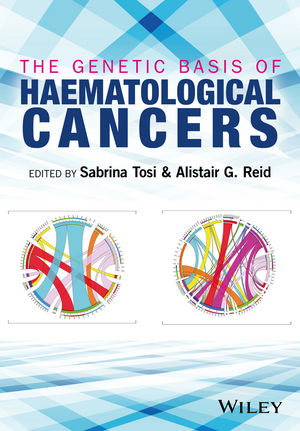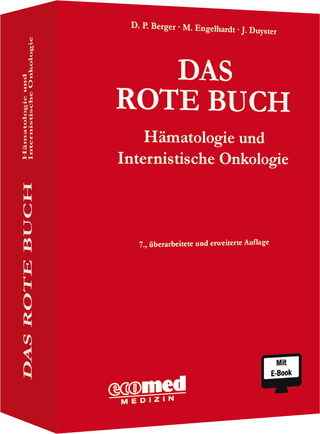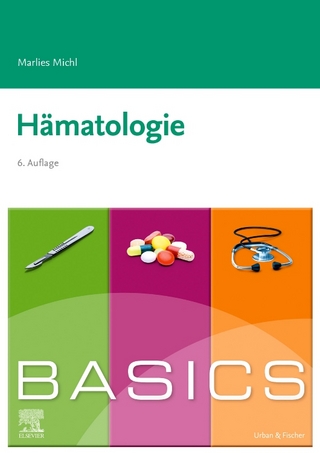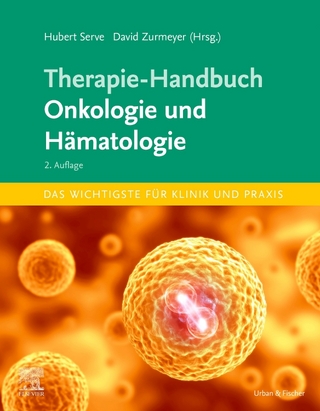
The Genetic Basis of Haematological Cancers
Wiley-Blackwell (Verlag)
978-0-470-97938-9 (ISBN)
The Genetic Basis of Haematological Cancers reviews the etiology and significance of genetic and epigenetic defects that occur in malignancies of the haematopoietic system. Some of these chromosomal and molecular aberrations are well established and already embedded in clinical management, while many others have only recently come to light as a result of advances in genomic technology and functional investigation. The book includes seven chapters written by clinical and academic leaders in the field, organised according to haematological malignancy sub-type. Each chapter includes a background on disease pathology and the genetic abnormalities most commonly associated with the condition. Authors present in-depth discussions outlining the biological significance of these lesions in pathogenesis and progression, and their use in diagnosis and monitoring response to therapy. The current or potential role of specific abnormalities as novel therapeutic targets is also discussed. There is also a full colour section containing original FISH, microarrays and immunostaining images.
Dr Sabrina Tosi graduated in Biological Sciences at the University of Milan (Italy) in 1989 and then attained her post-graduate degree in Human Cytogenetics at the University of Pavia (Italy) in 1992. Her interest in leukaemia dates back to 1989, when she started to work as a research scientist in the Department of Paediatric Haematology, Ospedale San Gerardo, Monza (Italy). In 1991-1992 Dr Tosi spent a year in the Oncogenetic Laboratory, Children's Hospital, University of Giessen (Germany) as a visiting research scientist. After another two years in Monza, Dr Tosi moved to the University of Oxford at the Weatherall Institute of Molecular Medicine, where she attained her DPhil in 1999 and spent altogether 12 years in leukaemia research. In 2005 she was appointed as Lecturer in Biosciences at Brunel University London, where she continues to work on the contribution of chromosomal abnormalities to leukaemia, with particular interest towards paediatric leukaemia. Dr Alistair Reid graduated in Genetics from the University of Newcastle upon Tyne in 1995, and trained as a diagnostic genetic scientist in the UK heath service. He obtained his PhD in Cambridge in 2003 based on the characterization of novel genetic prognosticators in myeloid leukemia. Since then he has held positions at several clinical academic haematology centres including Royal Free, London and University Children’s Hospital, Zurich, and has also spent time as a consultant in the genetic diagnostics industry. In 2006 he was appointed Consultant Clinical Scientist in Molecular Pathology at Imperial College Healthcare Trust in London. He has an active laboratory-based translational research program focused on the genetics of myeloid leukemia and holds an honorary senior clinical lectureship for the development of novel methods of personalized genetic management in malignancy. Dr Reid has contributed to over 60 papers on malignancy genetics and was awarded fellowship of the Royal College of Pathologists in 2011.
List of contributors xi
Preface xiii
1 The myelodysplastic syndromes 1
Cristina Mecucci, Valeria Di Battista and Valeria Nofrini
Introduction 1
Predisposing conditions 2
Familial platelet disorder with propensity to myeloid malignancy (FPD/AML) 2
Severe congenital neutropenia (SCN) 5
Poikiloderma with neutropenia 6
Familial MDS/AML 6
Shwachman–Diamond syndrome (SDS) 7
Dyskeratosis congenita (DKC) and telomere syndromes 8
Fanconi anaemia (FA) 11
Down syndrome 12
Cytogenetics 12
Loss of Y chromosome (–Y) and del(11q) 13
Del(20q) 15
idic(X)(q13) 15
Del(17)(p13)/i(17q) 15
Del(12p) 16
Trisomy 8 16
Rare trisomies: +6, +13, +14, +15, +16, +19, +21 16
Monosomy 7 and del(7q) 17
Rare monosomies 19
Unbalanced translocations involving 1q 19
t(17;18)(p10;q10) 20
Rare or sporadic balanced translocations 20
Complex karyotypes 22
Chromosome 5q deletions 23
Somatic mutations 31
Oncogenes and tumour suppressor genes 31
Mutations of genes involved in epigenetic modulation 39
Mutations of genes involved in the spliceosome machinery 45
Rare gene mutations in myelodysplastic syndromes 48
Epigenetics 49
DNA methylation 50
Histone modifications 52
RNA 53
Conclusion 54
References 54
2 Molecular genetics of the myeloproliferative neoplasms 80
Philip A. Beer
Introduction 80
Overview of the different types of mutation found in MPN patients 80
Acquired mutations in cytokine signalling pathways 82
Acquired mutations in pathways controlling transcriptional regulation 84
Acquired mutations associated with transformation to advanced-phase disease 87
Inherited predisposition to clonal MPNs 87
Inherited non-clonal disorders that phenocopy distinct MPNs 87
Polycythaemia vera (PV), essential thrombocythaemia (ET) and primary myelofibrosis (PMF) 88
Acquired mutations in cytokine signalling pathways (Table 2.3) 89
Acquired mutations in pathways controlling transcriptional regulation (Table 2.4) 95
Acquired mutations associated with progression to advanced and blastic-phase disease 101
Inherited predisposition to clonal MPNs 103
Inherited non-clonal disorders that phenocopy distinct MPNs 104
Principles and clinical utility of laboratory testing 107
Chronic eosinophilic leukaemia 109
Acquired mutations in cytokine signalling pathways 109
Acquired mutations in pathways controlling transcriptional regulation 113
Acquired mutations associated with progression to advanced and blastic-phase disease 113
Inherited predisposition to clonal MPNs 113
Inherited non-clonal disorders that phenocopy distinct MPNs 114
Principles and clinical utility of laboratory testing 114
Neoplastic mast cell disease 115
Acquired mutations in cytokine signalling pathways 116
Acquired mutations in pathways controlling transcriptional regulation 118
Acquired mutations associated with progression to advanced and blastic-phase disease 118
Inherited predisposition to clonal MPNs 119
Inherited non-clonal disorders that phenocopy distinct MPNs 119
Principles and clinical utility of laboratory testing 120
References 121
3 Acute myeloid leukaemia 133
Matthew L. Smith and Thomas McKerrell
Introduction 133
AML classification 134
Cytogenetic aberrations 135
Fusion genes arising from structural rearrangements 135
Monosomies 148
Complex and monosomal karyotypes 148
Trisomies 148
Double minute chromosomes 151
Normal karyotype – is it really normal? 151
Altered gene expression 152
EVI1 152
BAALC 153
MN1 153
ERG 154
SET 154
BRE 154
WT1 154
miRNA genes 154
Diagnosis and classification of AML 155
Current risk stratification of AML patients: European LeukemiaNet (ELN) guidelines 156
Therapeutic regimens in AML 158
Management of younger adults aged 18–60 years 159
Older AML patients (aged >60 years) 159
Novel agents 160
Monitoring response to therapy (MRD) 160
The genomics of AML 161
Clonal evolution of AML 161
Established recurrent mutations in AML 163
Novel recurrent mutations in AML 173
Emerging concepts and future directions 179
Age-related clonal haematopoiesis (ARCH) 179
Application of genomic technologies to the diagnosis of AML 179
Conclusion 181
Mini-glossary 183
References 184
4 Molecular genetics of paediatric acute myeloid leukaemia 203
Marry van den Heuvel-Eibrink, Jasmijn D.E. de Rooij and Christian Michel Zwaan
Clinical introduction 203
Epidemiology of AML 203
Diagnostic approach 204
Treatment and outcome 205
Relevant molecular and genetic aberrations in paediatric AML 206
Type I/II aberrations and their non-random associations 206
Relevance of type I/II aberrations for outcome and stratification of paediatric AML treatment 209
Epigenetic modifiers and hydroxymethylation pathway mutations 212
Further strategies 213
Further genomic approaches to unravelling the biology of paediatric AML 213
Molecularly targeted therapy 214
Conclusion 215
References 215
5 Acute lymphoblastic leukaemia 223
Anna Andersson, Anthony V. Moorman, Christine J. Harrison and Charles Mullighan
Introduction 223
Chromosomal aberrations in BCP-ALL 224
High hyperdiploidy 227
t(12;21)(p13;q22)/ETV6-RUNX1 232
t(1;19)(q23;p13)/TCF3-PBX1 233
t(17;19)(q22;p13)/TCF3-HLF 234
Hypodiploidy 234
11q23/KMT2A (MLL) gene rearrangements 236
t(9;22)(q34;q11.1)/BCR-ABL1 237
Intrachromosomal amplification of chromosome 21 (iAMP21) 238
Complex karyotype 239
Submicroscopic genetic alterations in BCP-ALL 240
Alteration of transcription factors in BCP-ALL 241
CRLF2 rearrangements and Janus kinase mutations in ALL 242
BCR-ABL1-like or Ph-like ALL 243
ERG-altered ALL 245
Genetic rearrangements in T-lineage ALL 245
TAL1/LMO2 rearranged T-ALL 247
TLX1/TLX3 rearranged T-ALL 248
Early T-cell precursor ALL 249
Other T-ALL genetic subtypes: MLL rearranged and PICALM-MLLT10 250
Relapsed ALL 251
Future directions 252
References 252
6 The genetics of mature B-cell malignancies 265
Jonathan C. Strefford, Jude Fitzgibbon, Matthew J.J. Rose-Zerilli and Csaba Bödör
Introduction 265
Chronic lymphocytic leukaemia 266
Immunoglobulin heavy-chain variable region gene mutational status 267
Chromosomal banding and interphase molecular cytogenetics 268
Copy number alterations 269
Deletions of 13q14 269
Trisomy 12 272
Deletions of 11q24 and mutations of ATM 273
Deletions of 17p13 and mutations of TP53 275
Other copy number alterations in CLL 276
Genome complexity and chromothripsis 277
Novel mutations in patients with CLL 279
NOTCH1 280
SF3B1 281
Other genes 282
Novel genetic mutations in clinical practice 282
Germinal centre lymphomas 284
Follicular lymphoma 286
Diffuse large B-cell lymphoma 293
Conclusions and future perspectives 296
Acknowledgements 299
References 299
7 The genetics of chronic myelogenous leukaemia 312
Philippa C. May, Jamshid S. Khorashad, Mary Alikian, Danilo Perrotti and Alistair G. Reid
Introduction 312
Clinical features 313
The structure and physiological function of BCR and ABL1 316
The structure of the BCR-ABL1 fusion gene 317
Mechanisms of BCR-ABL1-induced oncogenesis 319
Potential mechanisms underlying the genesis of CML 320
CML blast crisis transformation 321
Tyrosine kinase inhibitor (TKI) therapy 325
The genetic basis of TKI resistance 326
Novel therapeutic approaches 330
Genetics in patient management 332
Cytogenetic and molecular cytogenetic monitoring 332
Quantitative reverse transcriptase polymerase chain reaction (RT-qPCR) 334
BCR-ABL1 mutation analysis 337
Conclusion 338
References 339
Index 359
| Erscheint lt. Verlag | 2.5.2016 |
|---|---|
| Verlagsort | Hoboken |
| Sprache | englisch |
| Maße | 178 x 252 mm |
| Gewicht | 771 g |
| Themenwelt | Medizinische Fachgebiete ► Innere Medizin ► Hämatologie |
| Medizin / Pharmazie ► Medizinische Fachgebiete ► Onkologie | |
| Studium ► 2. Studienabschnitt (Klinik) ► Humangenetik | |
| Naturwissenschaften ► Biologie ► Genetik / Molekularbiologie | |
| ISBN-10 | 0-470-97938-0 / 0470979380 |
| ISBN-13 | 978-0-470-97938-9 / 9780470979389 |
| Zustand | Neuware |
| Haben Sie eine Frage zum Produkt? |
aus dem Bereich


